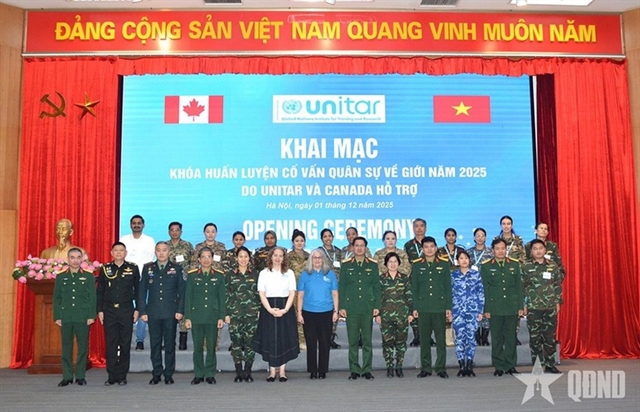.jpg) Society
Society

| A flycam is first sent to scout and identify the locations of residents in need, after which the drones deliver and drop essential supplies directly to those otherwise-inaccessible spots. VNS Photo Bảo Long |
Thu Vân
BẮC NINH — It was 2am on October 9 when Lê Đình Long received a message asking him to join a team of drone operators to deliver essential supplies to people stranded in flood-hit areas of the northern province of Bắc Ninh.
By 8am the next morning, in the central province of Hà Tĩnh, Long set off in his pickup truck with two drones, normally used for his daily work in agriculture, along with all the necessary gear: two generators, walkie-talkies, a chainsaw and a cutter—basically everything that could be useful.
Long arrived in Hoàng Vân Commune at 3.30pm. Ten villages were underwater and nearly 4,000 people were trapped.
Đinh Xuân Toàn, another drone operator from Hà Nội, departed at noon and arrived at 4pm.
Trần Duy Tiệp, a freelance drone operator, reached the meeting point at 5.30pm.
Joining them were several others from the Central Highlands, Kiên Giang and HCM City, strangers who had only known one another through social media and had suddenly become teammates.
Wasting no time, they made their first flight at 4pm. Relief goods reached local residents in an emotional atmosphere.
How it all began
On the night of October 9, when much of northern Việt Nam was submerged in floodwaters and thousands of residents stayed awake on rooftops, trapped by rising water, meteorological and hydrological expert Nguyễn Ngọc Huy posted a short Facebook status suggesting that agricultural drones could be used to air-drop relief supplies to stranded victims.
Moments later, he raised the idea in a group chat with friends already coordinating flood relief efforts. One friend, Quang Vịnh, responded with a simple question: “Do you need drones?”
That message marked the beginning of something extraordinary. Within just a few hours, the drone team was born.
Members began scouring the city for generators to charge drone batteries. Huy didn’t hesitate to wake someone he had never met in person to borrow several large power generators.
“We need a few more people with small drones to act as scouts, assess the terrain and guide the larger drones,” one member wrote in the group chat. “It would be great to have more agricultural drone pilots too, so we can take turns and operate at full capacity.”
By the afternoon of October 10, the group’s drones were operating simultaneously at four sites in Bắc Giang Province, with around ten aircraft in total.
“Through just messages and comments on social media posts, we somehow managed to coordinate and work together very smoothly, responsibly, quickly and precisely,” Vịnh said.
The sight of drones flying through mist and rain, carrying boxes of supplies, was deeply emotional for the group.
At that moment, they became a bridge between the relief teams and people in the flood zone.
Despite being a self-organised volunteer team formed within hours, safety was their top priority.
Quang Vịnh said: “Even though the group came together spontaneously, we still organised everything according to a clear process. Before launching the large drones, we used flycams to map the terrain of the target areas, especially those unreachable by boats or canoes, or where the water currents were too strong. Then the larger agricultural drones would carry food and essential goods to those exact coordinates.
“The rope attaching the package to the drone is over 30 metres long, enough to ensure that the recipient can safely approach the package. Each drop point is mapped with precise coordinates, so accuracy is absolute.”
Every five to seven minutes, a drone could deliver a relief package weighing 30–40 kilogrammes to people up to 1.5 kilometres away. In a single day, two drones were able to make 140 deliveries to residents.
Lê Đình Long from Hà Tĩnh Province said the method is very effective, especially since boats and canoes cannot reach many of these flooded areas.
Each time a drone returned, a team member would rush forward to swap its battery before sending it back into the sky.
“The models we’re using have a short flight range and limited battery life. So identifying the exact coordinates for delivery is critical, not just to ensure that aid reaches the right people, but to protect the equipment. If a drone crashes, repairs can cost hundreds of millions of đồng,” Vịnh said.
Compassion behind the controls
Having worked in agriculture for ten years, Long is an experienced drone operator. As someone living in a flood-prone region himself, he understands the suffering such disasters bring.
“The floods in Hà Tĩnh were already terrible, but this time it’s even worse here. People are suffering so much,” he said.
Trần Duy Tiệp shared that this was not his first time using drones for humanitarian aid.
“When Typhoon Yagi hit Việt Nam in 2024, my friends and I tried to use drones for rescue efforts in Yên Bái, but we didn’t have much experience then, so it wasn’t very successful,” Tiệp recalled.
“This year, with more experience, things went much better. In one day, our team managed to deliver 140 packages to flood victims. It’s actually much more efficient. Once we can locate where people are, the drones can reach even the deepest, isolated areas. As long as the distance is safe and the battery lasts long enough, we can help,” he said.
Đinh Xuân Toàn, from Hà Nội, who works in the agricultural drone field, drove up with a fully equipped vehicle to Bắc Ninh.
“Our operation is completely self-contained. Everything we need is on our vehicle, so we don’t need any extra support; we can arrive and start flying right away. Also, since residents here have lost power, I brought extra equipment so people can charge their phones too,” he said.
The long nights and difficult flights were not just about logistics or technology. For many in the team, what drove them was something deeper: a shared sense of compassion, purpose and pride in helping their fellow citizens.
Quang Vịnh recalled: “When I first spoke with Huy, I already had a plan in place and was confident that many others would come together. We were doing this with sincerity and completely selfless intentions, so I believed people would understand and join in."
For Trần Duy Tiệp, the motivation is simple but profound.
“Honestly, the feeling is overwhelming. When you see people waving their hands and catching the relief packages, it’s so emotional. You can’t really describe it. It just fills you up inside,” he said.
Đinh Xuân Toàn, from Hà Nội, shared similar feelings.
“At first, I was nervous. Looking down, the water was endless. When I arrived yesterday, the flood level was two metres higher. Today it has dropped, but still, seeing everything from above makes your hands shake. So many rooftops underwater. At first, I was shocked, but now I’m used to it. Still, I feel happy and proud that I can contribute even a small part to the fight against the storm.”
After the floods: Cleaning and recovery
According to Vịnh, once the water recedes, cleaning up homes and neighbourhoods becomes even more critical than food relief.
“If we don’t clean properly, diseases could spread quickly and affect the entire community,” he said.
Relying solely on local medical teams to disinfect flooded areas would take far too long. Instead, using agricultural drones to spray disinfectants is 10 to 15 times faster than manual labour. For that reason, Huy and Vịnh’s drone group plans to continue helping flood-affected communities until they are fully recovered.
Vịnh added that, if local authorities agree and the Government instructs coordination with volunteer teams, the group could contribute even more in the post-flood period.
“For example, drones can be used to spray disinfectants, which is extremely important, or to deliver essential supplies to specific areas that remain isolated by mud and debris, where boats cannot reach and vehicles can barely get through,” he explained.
Nguyễn Đình Hương, Vice Chairman of the People’s Council of Hoàng Vân Commune in Bắc Ninh Province, said he clearly recognised the need to apply technology in disaster response.
“During the flood, we mobilised many resources, using boats and canoes to reach households in completely isolated hamlets. But with strong currents and difficult terrain, boats couldn’t reach certain areas. In those cases, the drones proved highly effective,” he said.
“With the Government calling for the adoption of technology, we also need to strengthen our own capacity to use it, not only in disaster response, but across many other areas of work,” Hương added.
With no central command structure, everything is coordinated through radio and social media. Yet this flexibility has made their operation remarkably effective.
In just a few days, these volunteers, strangers united by compassion and technology, turned agricultural tools into lifelines. In the face of devastating floods, they built not only a network of drones but a bridge of solidarity across Việt Nam’s storm-hit north. — VNS




